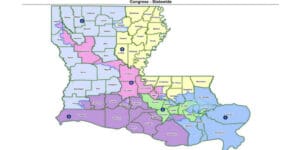Last week, the US Supreme Court began oral arguments for the key Congressional redistricting court case – Louisiana vs. Callais. At the crux of this court case is Louisiana’s heavily gerrymandered 6th US Congressional district (Cleo Fields’s district) and the validity of Section 2 of the Voting Rights Act (VRA).
For everyone following this issue, Congressional redistricting in Louisiana has remained as a major political issue for over three years. Going back to January 2024, Governor Jeff Landry called a special session to create a new Congressional map for Louisiana that created a 2nd black-majority Congressional district. The Louisiana Legislature passed this map in order to comply with a bogus court order–which required a 2nd minority-majority district–from the activist US District Judge Shelley Dick.
This legal and legislative battle culminated in the current monstrosity of a Congressional map that Louisiana currently possesses (SB 8, 2024). The “Republican supermajority” passed a Congressional map that provided Cleo Fields with an easy path to re-entering US Congress via the 6th Congressional district.
In January 2024, Governor Jeff Landry publicly supported this terrible map, endorsed this terrible map, and signed this terrible map into law. You can find the post below from Governor Landry’s official Twitter/X account following the passing of Louisiana’s current Congressional district map:
What’s more, this new Congressional map fulfilled two political objectives for Governor Landry. Not only did the new map comply with Judge Dick’s court order to create a 2nd black-majority district to help the Democratic party in Congress, it also helped Governor Landry eliminate the old Congressional district of his political rival Garret Graves.
After supporting this Congressional map for nearly two years, Governor Landry and AG Liz Murrill have suddenly flipped their position by publicly arguing against the current Congressional map that Landry signed into law in January 2024.
According to AP news, Louisiana’s top Republican officials are now attacking the very map that they approved of in 2024. Now the that the US Supreme Court seems to be leaning toward rejecting Louisiana’s Congressional map, it seems pretty convenient that Landry and Murrill have changed their position:
“Louisiana on Wednesday abandoned its defense of a political map that elected two Black members of Congress and instead called on the Supreme Court to reject any consideration of race in redistricting in a case that could bring major changes to the Voting Rights Act.
Appealing to a conservative-dominated court that has been skeptical of the use of race, Louisiana is advancing a position that could allow it and other Republican-led states in the South to draw new maps that eliminate virtually all majority Black districts, which have been Democratic strongholds, voting rights experts said.”
In a similar vein, Governor Landry made a media appearance on Fox News on Wednesday to talk about the Louisiana vs. Callais case in the US Supreme Court. Again, Landry attacked the map that he signed off on in January 2024.
 Don’t get me wrong, both myself and many other people in Louisiana are finally glad to see Governor Landry and AG Murrill rightly critiquing racially-gerrymandered Congressional districts that disregard concerns for compactness or communities of interest.
Don’t get me wrong, both myself and many other people in Louisiana are finally glad to see Governor Landry and AG Murrill rightly critiquing racially-gerrymandered Congressional districts that disregard concerns for compactness or communities of interest.
My only problem here is the blatant flip-flop that Landry and Murrill are hoping that the voting public forgot about. Landry and Murrill’s support for Louisiana’s current Congressional map gave Louisiana another term of Congressman Cleo Fields and almost gave us a Democratic House majority for President Trump’s first two years back in office.
The people of Louisiana deserve a better explanation for why Landry and Murrill put us through this debacle instead of fighting this redistricting battle during the legislative special session back in January 2024.
Let’s hope that the Supreme Court eventually can finally put the years-long Congressional Redistricting fiasco to bed in Louisiana by getting rid of our state’s current Congressional district map.
Advertisement
Advertisement



